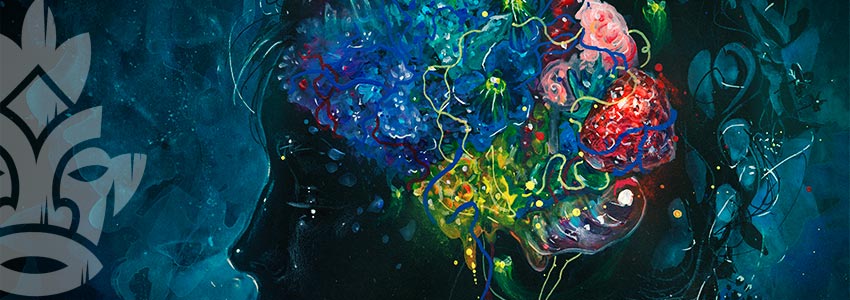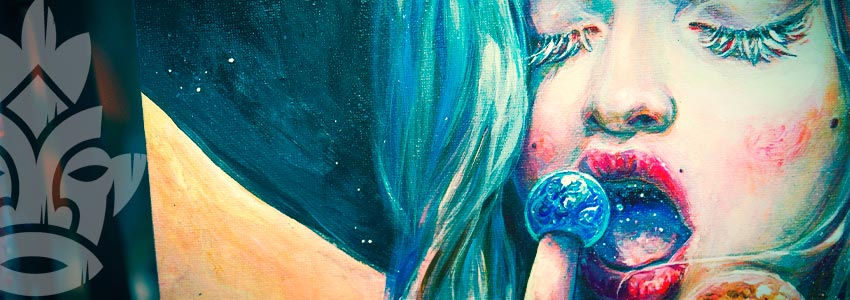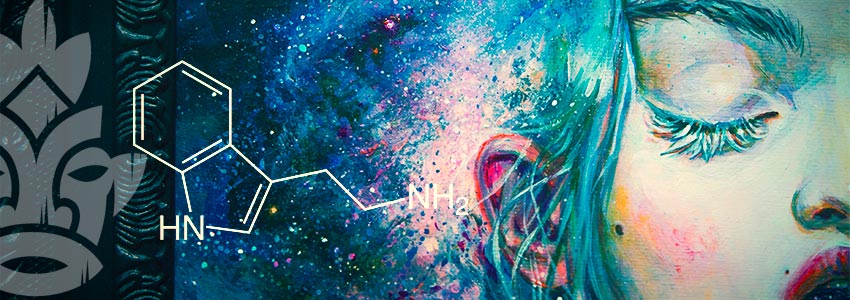Don't have an account?
Register NowYou have to add to cart at least 5 bottles or any program to make checkout.
- BlogWhich Chemicals Power Your Psychedelic Experience?
Which Chemicals Power Your Psychedelic Experience?
Published: April 16th, 2020
Categories:
Other subjects
If you're reading this, chances are you have some experience with psychedelics. But, have you ever wondered how exactly these substances—such as LSD and magic mushrooms—make you trip? Let's take a closer look at the science behind tripping. To do so, we’ll need to dive into the chemical compounds in psychedelics—tryptamines, phenethylamines, and lysergamides. But first, let’s take a look at psychedelics in general.
WHAT ARE PSYCHEDELICS?
Psychedelics are psychoactive substances that produce changes in perception, mood, and cognition. They can alter our sense of reality and time, change the way we think, and cause hallucinations, visions, and other sensory effects.
Some psychedelic substances occur naturally in certain plants, seeds, fungi, and animals. Other psychedelic substances are synthetic, and thus created in a lab setting. Lysergic acid diethylamide, better known as acid or LSD, is possibly the most well-known psychedelic drug. Other psychedelic substances include psilocybin (found in magic mushrooms), mescaline (found in certain cacti like peyote and San Pedro), and DMT, a psychedelic that occurs naturally in numerous plants and animals, and comprises a key ingredient in the ayahuasca brew.
WHAT ARE PSYCHEDELICS USED FOR?

Psychedelics are used for a variety of purposes. Today, some people take them recreationally, often as a way to escape boredom, or to enrich their lives with new insights.
Taking psychedelics for recreational purposes wasn’t all too widespread in the Western world until the discovery of LSD in the early 1940s. Following that, LSD and other psychedelics became popular drugs of choice (not just) among a rising counterculture. Musicians, poets, painters, and filmmakers have all used (and continue to use) psychedelics for creative inspiration.
In other cultures, psychedelic substances have long been used for spiritual or ceremonial purposes. In many parts of the world, people take psychedelics to produce mystical visions, to gain enlightenment, and to bring themselves closer to the spirit world. Since ancient times, shamans have taken (and given) psychedelics for spiritual purposes. Indeed, in some belief systems, the consumption of psychedelic substances plays a central role in gaining spiritual growth and knowledge.
USES FOR PSYCHEDELICS

In the West, psychedelic drugs soon fell out of favour among the establishment, which declared them illegal. This has made scientific research regarding the possible uses of psychedelics difficult. Only in recent times, with drug laws becoming more relaxed in many countries, have scientists had greater opportunities to comprehensively examine psychedelics.
Microdosing, where one only takes very small amounts of a psychedelic to improve creativity and focus, has recently also become quite popular. Recent research suggests that psychedelics may promote structural changes in the brain, with long-lasting benefits.
THE CHEMICAL COMPOUNDS IN PSYCHEDELICS

Psychedelic substances sustain profound effects on our perception and thinking as they directly affect the functions of the brain. Among the major psychedelic chemical compounds are tryptamines, phenethylamines, and lysergamides.
TRYPTAMINES
Tryptamine is a monoamine alkaloid found in tiny amounts in the mammalian brain, and larger amounts in plants. Tryptamines belong to the classic serotonergic hallucinogens that bind to 5-HT2A serotonin receptors in the brain. Serotonin is a neurotransmitter that contributes to feelings of well-being and happiness, although it has a multitude of functions related to learning, memory, reward, and many other physiological processes.
Well-known tryptamines include lysergic acid diethylamide (LSD), psilocybin, and dimethyltryptamine (DMT).
Recently, new synthetically produced tryptamines, such as alpha-methyltryptamine (AMT), 5-methoxy-N,N-dimethyltryptamine (5-MeO-DMT), and 5-methoxy-N,N-diisopropyltryptamine (5-MeO-DIPT) have emerged on the recreational drug market, sometimes marketed as “legal alternatives” to LSD. Research on the safety of these new designer drugs is still ongoing.
It’s worth noting that LSD can be considered a tryptamine, a phenethylamine, and a lysergamide based on its structure, and this topic is widely disputed.
PHENETHYLAMINES
Phenethylamine, like tryptamine, is a monoamine alkaloid found naturally in the body, where it acts as a mild central nervous system stimulant, and to some extent, a neurotransmitter. Phenethylamine is sometimes called the “love drug” because it improves mood and can aid weight loss and athletic performance. It is found naturally in chocolate and cocoa products, as well as in beans, nuts, lentils, meat, and dairy. You can access phenethylamine as a dietary supplement.
So-called substituted phenethylamines are a group of phenethylamine derivatives formed by replacing one or more hydrogen atoms in the phenethylamine core structure with substituents. Drugs based on substituted phenethylamines include many types of stimulants and amphetamines, anorectics, decongestants, and others.
Some well-known drugs based on substituted phenethylamines include mescaline, DOM, MDMA (ecstasy), and methamphetamine.
LYSERGAMIDES
Lysergamides (amides of lysergic acid) are polycyclic amides which have both phenethylamine and tryptamine groups embedded in their chemical structure. Like tryptamines, lysergamides are believed to bind to serotonin (5-HT2A) receptors, where they act as a partial agonist. Compared to other psychedelic compounds, lysergamides are known to have an affinity for a much greater variety of receptors.
Lysergamides are a type of ergoline alkaloid, a class of compounds derived mainly from the ergot fungus, which grows on rye. The most famous ergoline derivative is LSD, which was accidentally discovered by Albert Hofmann as he was studying ergot as part of a programme to synthesise constituents for pharmaceuticals. Morning glory and Hawaiian baby woodrose seeds also contain ergoline alkaloids in the form of lysergic acid amide (LSA).
These psychedelics, including tryptamines like psilocybin and DMT, phenethylamines like mescaline, and lysergamides like LSD and LSA, are all referred to as “classical” or serotonergic hallucinogens.





